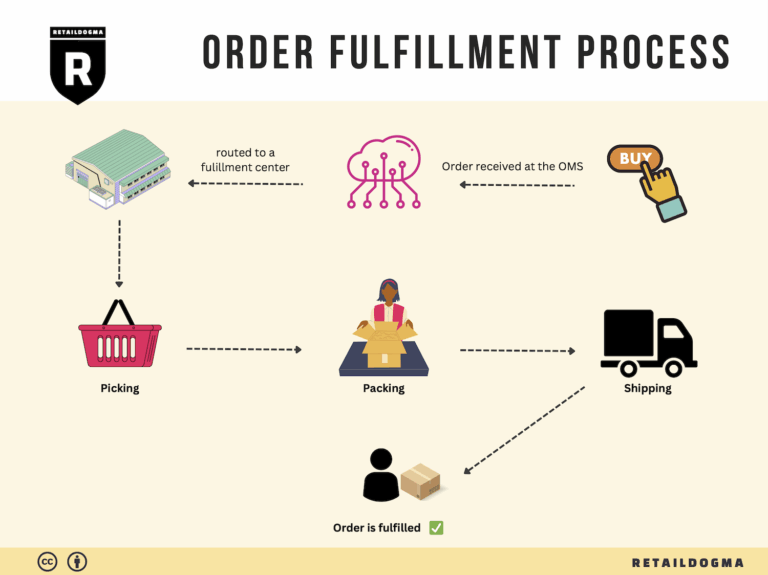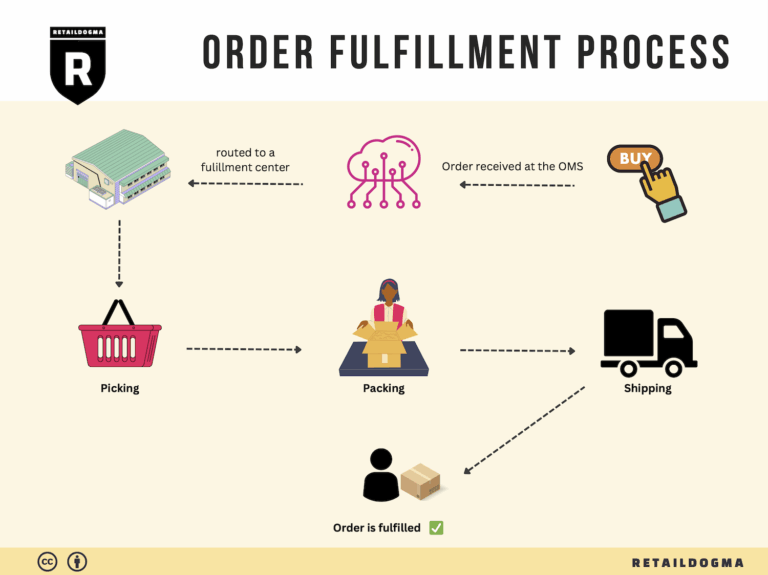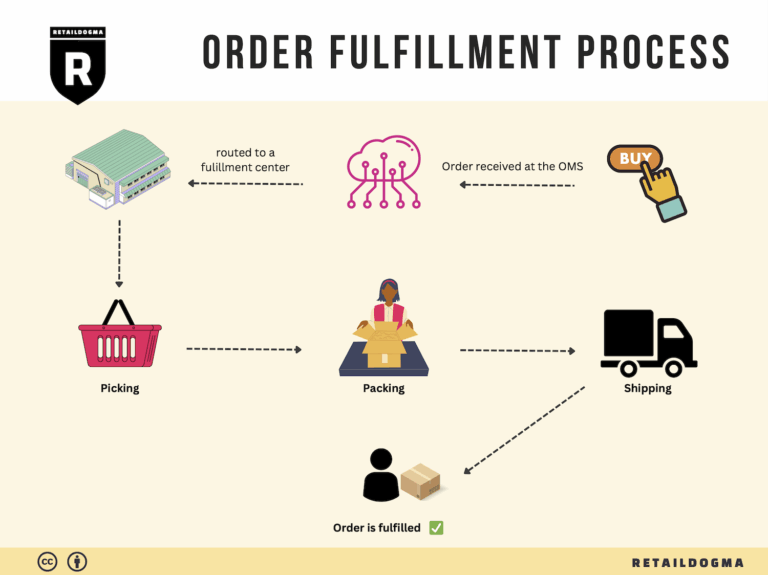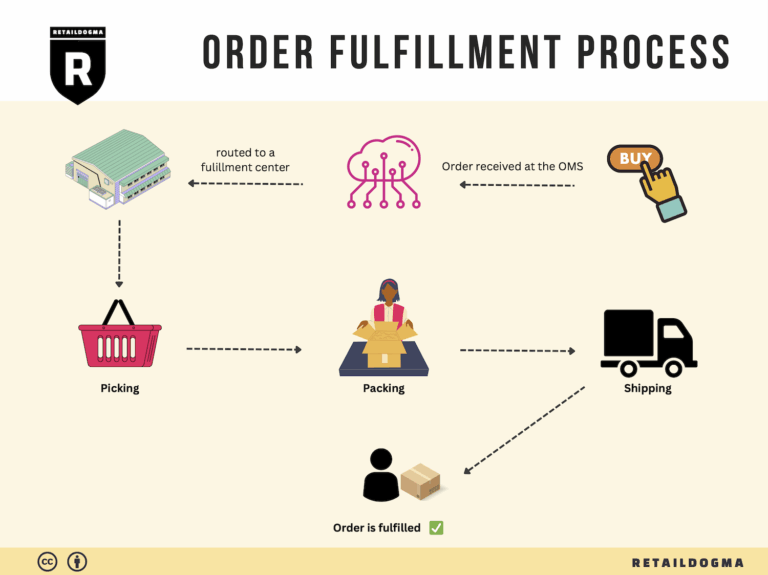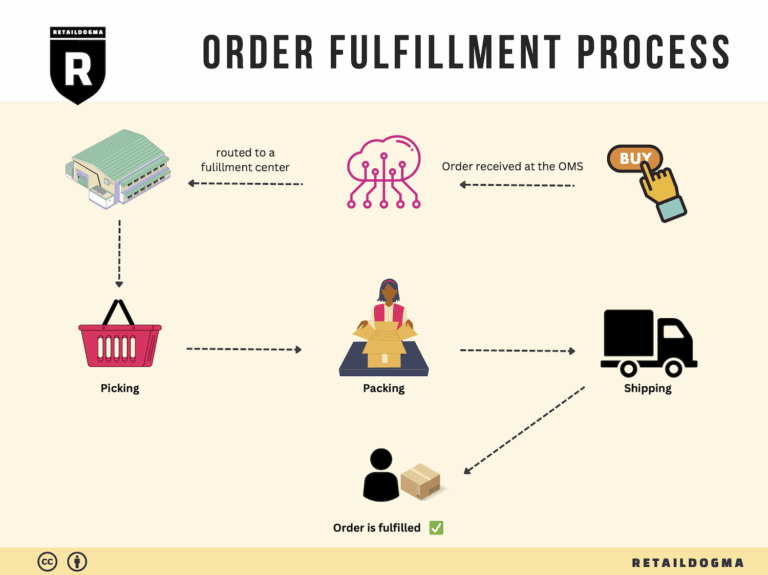What Is A Fulfillment Center? A Complete Guide (2025)
What is E-commerce Fulfillment? An Introduction for Growing Businesses
Understanding E-commerce Fulfillment
As an e-commerce business owner, you may find yourself drowning in the complexities of packing and shipping orders. The excitement of growing sales can quickly turn into a logistical nightmare if you’re unprepared. Managing inventory, ensuring timely delivery, and maintaining customer satisfaction can overwhelm even the most organized entrepreneurs. This is where e-commerce fulfillment comes into play—an essential process that ensures your products reach your customers efficiently and reliably.
E-commerce fulfillment simply refers to the steps involved in getting a product from your warehouse or supplier to the customer’s doorstep. This process encompasses everything from inventory management and order processing to packing and shipping. As your business scales, understanding the intricacies of fulfillment becomes crucial to sustaining growth and enhancing customer experience.
In this guide, we will explore various fulfillment models available to online businesses, including Third-Party Logistics (3PL) and Fulfilled by Amazon (FBA). Each model has its unique advantages and can cater to different business needs. For instance, partnering with a 3PL provider can streamline your operations by outsourcing logistics, while FBA offers the extensive reach and resources of Amazon’s fulfillment network.
We will also delve into the core services associated with e-commerce fulfillment. This includes warehousing, inventory management, order processing, packaging, and shipping. Understanding these services will help you identify what your business needs to operate smoothly.
Choosing the right fulfillment partner is critical for your success. We’ll provide insights into what to consider when selecting a logistics partner, including their experience, technology, service offerings, and pricing structures.
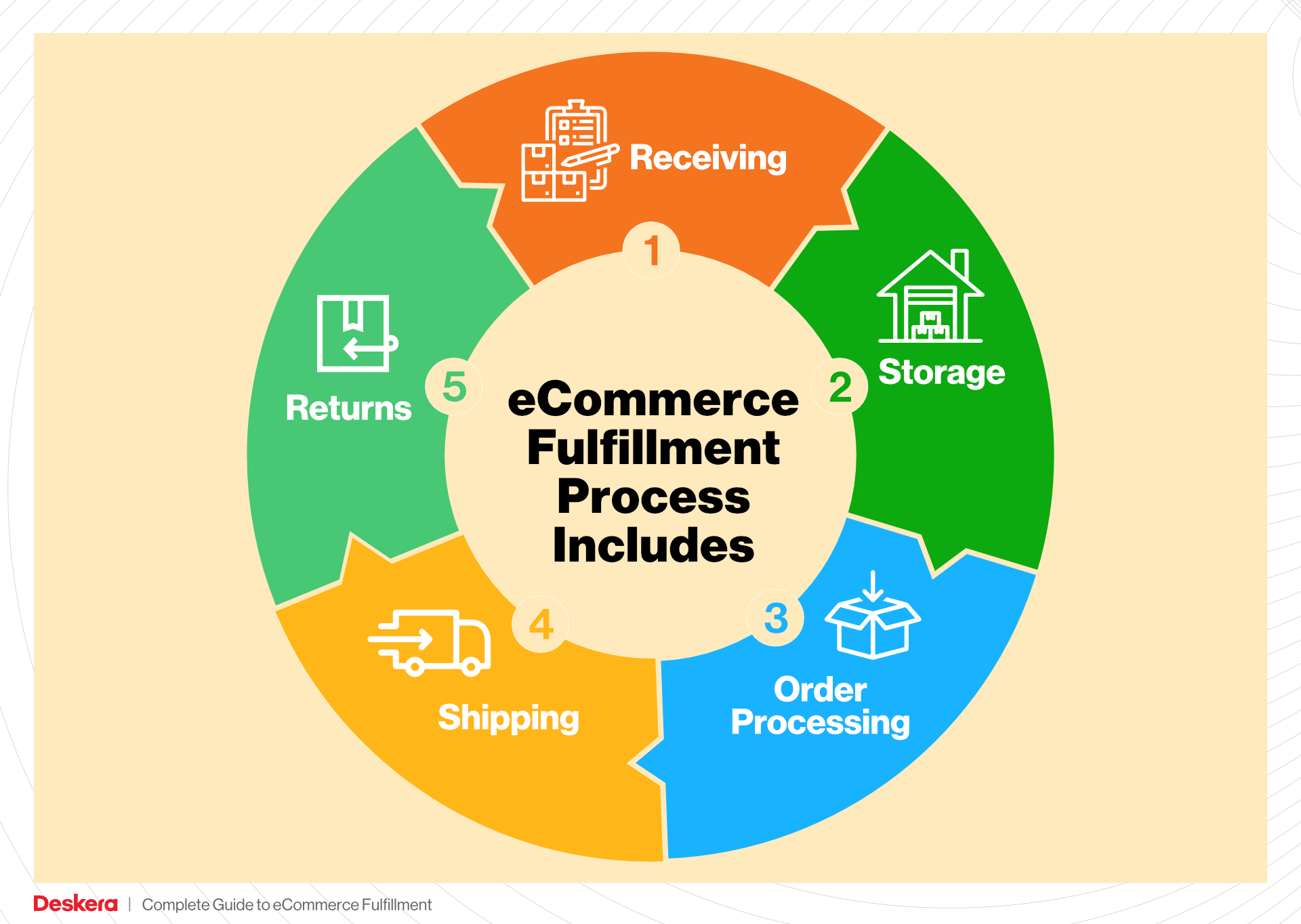
Speaking of pricing, we’ll cover the various cost factors associated with fulfillment services. From storage fees to shipping costs, having a clear understanding of these expenses will help you budget effectively and avoid unexpected financial strain.
The ultimate goal of this guide is to empower you to make informed decisions about your logistics operations. With the right knowledge and resources, you can optimize your fulfillment process, enhance customer satisfaction, and focus on what you do best—growing your business. By streamlining your logistics, you’ll not only reduce stress but also create a solid foundation for sustained success in the e-commerce landscape.
What You’ll Learn In This Guide
- What is E-commerce Fulfillment? An Introduction for Growing Businesses
- The Order Fulfillment Process: From ‘Buy’ Button to Customer’s Door
- Comparing Fulfillment Models: In-House vs. 3PL vs. Dropshipping
- A Deep Dive into Amazon FBA: Pros, Cons, and Who It’s For
- Core Services Offered by Fulfillment Centers
- How to Choose a Fulfillment Partner: A 6-Point Checklist
- Understanding Fulfillment Pricing: A Breakdown of Common Fees
- Frequently Asked Questions (FAQs) about Fulfillment
- Conclusion: Is Outsourcing Fulfillment the Right Move for Your Business?
- Important Disclaimer
The Order Fulfillment Process: From ‘Buy’ Button to Customer’s Door
1. Receiving Inventory
The first step in the order fulfillment process is Receiving Inventory. This involves the acceptance of goods into your warehouse or fulfillment center, such as Amazon’s Fort Worth location. When products arrive, they are checked against purchase orders to ensure accuracy in quantity and quality. This stage is crucial because any discrepancies can lead to stockouts or overstock situations, negatively impacting customer satisfaction and sales.
A key term associated with this step is SKU (Stock Keeping Unit). SKUs are unique identifiers assigned to each product, enabling efficient tracking and management of inventory. Properly managing SKUs during the receiving process ensures that products are easily located within the warehouse and helps maintain accurate stock levels. Timely and efficient receiving not only streamlines the overall fulfillment process but also sets the stage for effective inventory management moving forward.
2. Warehouse Storage
Once inventory has been received, the next step is Warehouse Storage. This involves organizing the products within the fulfillment center in a manner that maximizes space and enhances retrieval efficiency. Products are typically stored in designated areas based on size, type, and demand frequency. High-demand items are often placed in easily accessible locations, while less frequently ordered products may be stored further back.
The importance of this step cannot be overstated; efficient storage solutions reduce the time required for order picking and ultimately impact the speed of delivery. A key term here is ABC Analysis, a method used to categorize inventory based on importance and turnover rates. By employing ABC Analysis, businesses can prioritize their storage strategies, ensuring that the most valuable or frequently sold items are readily accessible, thus expediting the fulfillment process.
3. Order Picking
Order Picking is the process of selecting products from the warehouse to fulfill customer orders. When an order is placed, a pick list is generated, detailing the items and their respective locations within the warehouse. This step is critical as it directly affects order accuracy and fulfillment speed. Efficient picking processes can significantly reduce lead times, which is essential in today’s fast-paced e-commerce environment.
A key term associated with this step is Pick Zones. By implementing pick zones, warehouses can streamline the picking process by assigning specific areas for different types of products or orders. This organization helps pickers quickly locate items, reducing the time spent walking through the warehouse and increasing overall productivity. Effective order picking not only improves customer satisfaction through faster deliveries but also enhances operational efficiency.
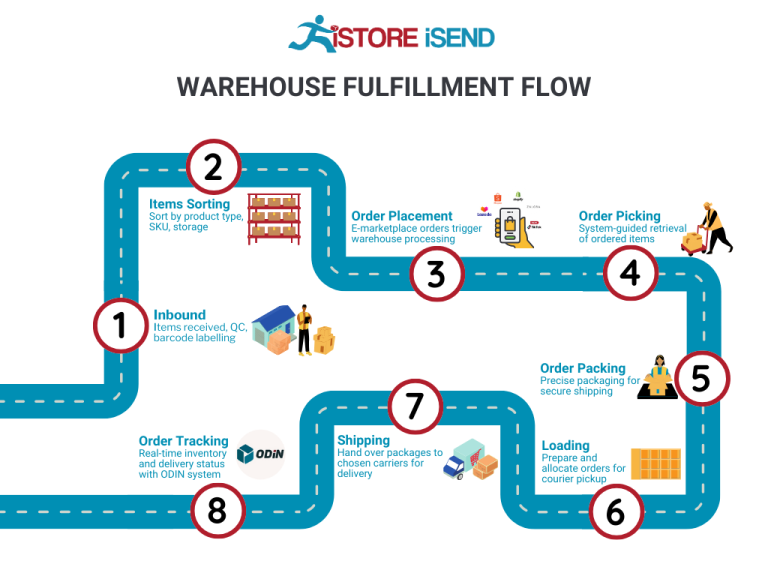
4. Order Packing
After the items have been picked, the next step is Order Packing. This involves securely packaging the selected products for shipment. Proper packing is essential to prevent damage during transit and to ensure that the customer receives their order in pristine condition. This step is also an opportunity to enhance the customer experience through thoughtful packaging design and branding.
A key term here is Packaging Materials. The choice of materials—such as boxes, bubble wrap, and packing tape—can significantly impact both the safety of the items and the overall cost of fulfillment. Utilizing the right packaging materials not only protects the products but also contributes to sustainability efforts if eco-friendly options are employed. Efficient packing processes can reduce costs and improve delivery times, making it a vital aspect of the fulfillment workflow.
5. Shipping & Delivery
The final step in the order fulfillment process is Shipping & Delivery. Once the order is packed, it is prepared for dispatch to the customer. This involves selecting the appropriate shipping method based on factors such as cost, delivery speed, and destination. Proper shipping logistics are crucial, as they directly influence the customer’s experience and satisfaction.
A key term associated with this step is Last-Mile Delivery. This term refers to the final leg of the shipping journey, where the package is transported from a distribution center to the customer’s doorstep. Efficient last-mile delivery is essential for meeting customer expectations in terms of speed and reliability. Utilizing technology and data analytics can help optimize delivery routes and improve overall efficiency. This final step ensures that the fulfillment process is completed, reinforcing the importance of timely delivery in building customer loyalty and trust in your brand.
By understanding and optimizing each step of the order fulfillment process, e-commerce businesses can scale effectively, enhance customer satisfaction, and drive sales growth.
Comparing Fulfillment Models: In-House vs. 3PL vs. Dropshipping
Fulfillment Models Comparison
| Model | Who Handles Inventory | Best For (Business Stage) | Key Advantage | Key Disadvantage |
|---|---|---|---|---|
| In-House Fulfillment | The business itself | Established businesses with steady demand | Full control over operations and branding | High overhead costs and resource intensive |
| Third-Party Logistics (3PL) | A third-party provider | Startups to medium-sized businesses | Cost efficiency and scalability | Less control over inventory and shipping processes |
| Dropshipping | Supplier or manufacturer | New businesses or niche markets | Low startup costs and no inventory risk | Lower profit margins and reliance on suppliers |
In-House Fulfillment
In-house fulfillment involves managing all aspects of the logistics process internally. This model is often adopted by established businesses that have sufficient demand to justify the investment in warehousing, staffing, and shipping. The key advantage of in-house fulfillment is the level of control it affords a business. Companies can ensure quality control, customize packaging, and maintain brand integrity throughout the fulfillment process. However, this model also comes with significant disadvantages. The costs associated with warehousing, labor, and equipment can be substantial, particularly for smaller businesses or those with fluctuating demand. Additionally, managing fulfillment in-house can divert focus from core business activities such as product development and marketing, potentially hindering growth.
Third-Party Logistics (3PL)
Third-party logistics (3PL) providers offer a comprehensive suite of services including storage, order processing, and shipping. This model is particularly beneficial for startups and medium-sized businesses that seek to streamline their operations without the burden of handling logistics themselves. By outsourcing fulfillment to a 3PL, businesses can benefit from economies of scale, reducing overhead costs and increasing efficiency. 3PLs often have established relationships with shipping carriers, which can lead to better rates and faster delivery times. However, one of the key disadvantages is the reduced control over inventory management and shipping processes. Businesses may face challenges in maintaining brand consistency and quality assurance, as they rely on external partners to represent their brand.
Dropshipping
Dropshipping is a fulfillment model where the retailer sells products without holding any inventory. Instead, when a customer makes a purchase, the retailer forwards the order to a supplier, who then ships the product directly to the customer. This model is particularly attractive for new businesses and niche markets due to its low startup costs and minimal financial risk. Since there’s no need to invest in inventory upfront, entrepreneurs can test various products and market trends without significant financial commitment. However, dropshipping also presents several challenges. Profit margins can be lower compared to traditional retail models due to the reliance on suppliers, and businesses may struggle with issues related to product quality and shipping delays, which can affect customer satisfaction. Moreover, as the retailer does not handle the inventory directly, they may face difficulties in maintaining brand loyalty and customer service consistency.
Conclusion
Choosing the right fulfillment model is crucial for e-commerce businesses looking to scale. Each model—whether in-house fulfillment, 3PL, or dropshipping—has its unique advantages and disadvantages that must be weighed against the specific needs and goals of the business. In-house fulfillment offers control but at a higher cost, while 3PL provides efficiency and scalability with some loss of control. On the other hand, dropshipping presents a low-risk entry point for new businesses but can lead to lower profits and potential customer service challenges. Understanding these nuances will help entrepreneurs and operations managers make informed decisions that align with their growth strategies and operational capabilities.
A Deep Dive into Amazon FBA: Pros, Cons, and Who It’s For
Understanding Fulfillment by Amazon (FBA)
Fulfillment by Amazon (FBA) is a service offered by Amazon that allows e-commerce sellers to store their products in Amazon’s fulfillment centers. Amazon takes care of storage, packaging, and shipping of the products directly to customers. Sellers can leverage Amazon’s extensive logistics network to enhance their sales and customer service capabilities.
How FBA Works
-
Product Storage: Sellers send their inventory to Amazon’s fulfillment centers, where products are stored in a secure and organized manner.
-
Order Processing: When a customer places an order on Amazon, the order is automatically processed by Amazon’s system. The products are picked from the inventory, packed, and shipped directly to the customer.
-
Customer Service: Amazon handles all aspects of customer service and returns for FBA orders. This allows sellers to focus on other aspects of their business while ensuring their customers receive quality service.
-
Multi-Channel Fulfillment: FBA can also be used for orders placed on other platforms, allowing sellers to fulfill orders from their own websites or other e-commerce platforms using Amazon’s logistics.
Pros of Using FBA
-
Prime Eligibility: One of the most significant advantages of using FBA is the ability to offer products with Amazon Prime eligibility. This can significantly increase sales, as Prime members often prefer products that are eligible for free two-day shipping.
-
Customer Trust: Products fulfilled by Amazon are often viewed as more reliable by customers. Amazon’s reputation for quality service enhances trust and can lead to higher conversion rates for sellers.
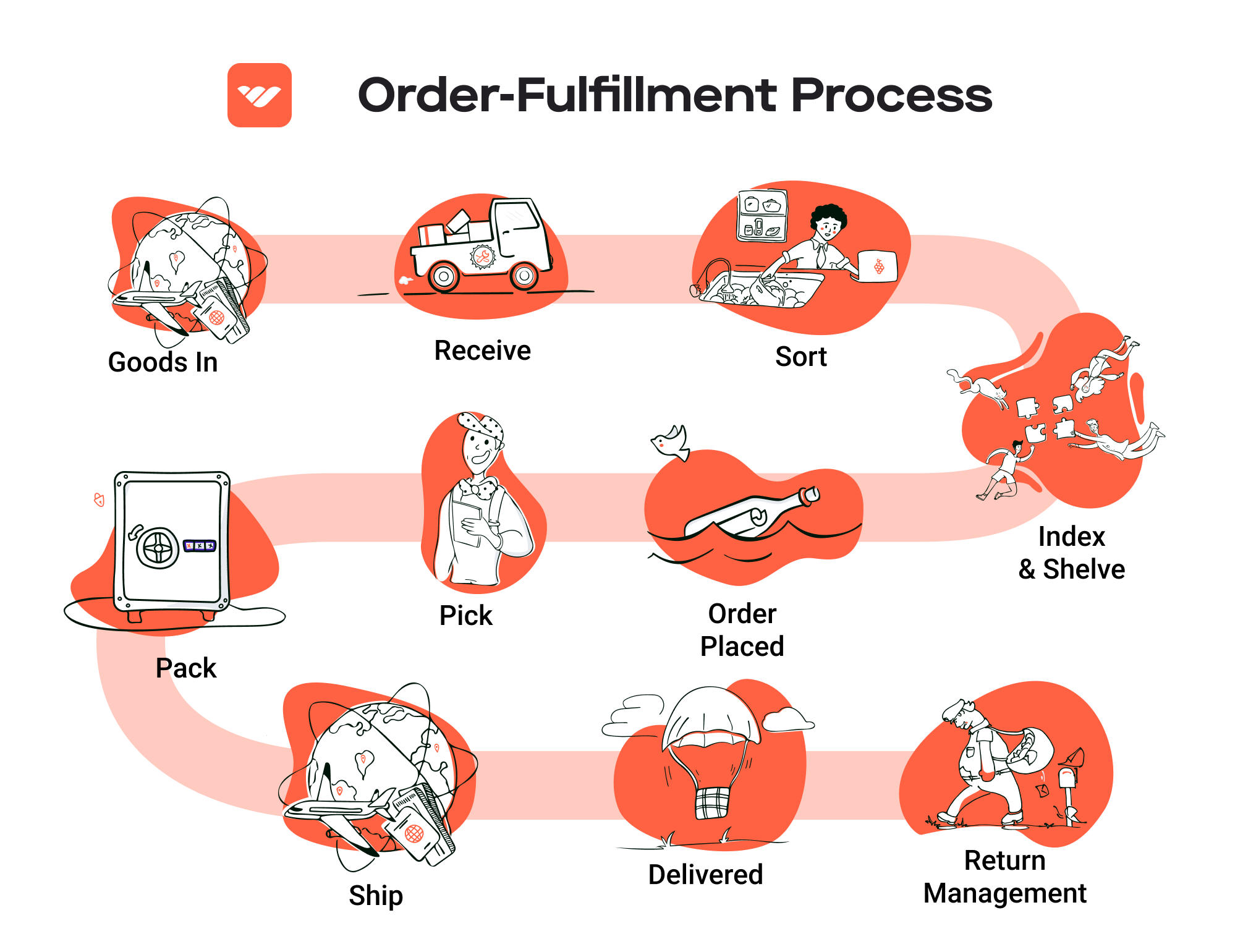
-
Scalability: FBA allows businesses to scale without the logistical headaches associated with warehousing and shipping. Sellers can focus on growing their product lines or marketing efforts rather than handling logistics.
-
Multi-Channel Fulfillment: As mentioned earlier, FBA is not limited to sales made on Amazon alone. Sellers can use FBA to fulfill orders from their own websites or other sales channels, streamlining their operations and ensuring a consistent customer experience.
-
Automated Returns Handling: Amazon manages returns for FBA sellers, which simplifies the process and enhances customer satisfaction. This can lead to better seller ratings and increased customer loyalty.
-
Efficient Shipping: With Amazon’s extensive distribution network, sellers benefit from quicker shipping times and reduced shipping costs, which can improve overall profit margins.
Cons of Using FBA
-
High Fees: While FBA can simplify logistics, it does come with costs. Sellers are charged for storage and fulfillment services, which can eat into profit margins, especially for low-cost items.
-
Strict Inventory Rules: Amazon has stringent guidelines regarding inventory management, including limits on storage space and requirements for labeling and packaging. Non-compliance can result in penalties or increased fees.
-
Commingling Risks: Products from different sellers may be stored together, which can lead to issues if a customer receives a product that doesn’t match their order. This can impact seller ratings and lead to customer dissatisfaction.
-
Limited Control: By using FBA, sellers relinquish control over the fulfillment process. Issues such as shipping delays or inventory mismanagement can occur, and sellers may have limited recourse.
-
Inventory Management Challenges: Sellers must carefully monitor their inventory levels to avoid stockouts or excess inventory. Overestimating demand can lead to increased storage fees, while underestimating can result in lost sales.
-
Dependency on Amazon: FBA can create a dependency on Amazon for sales and fulfillment. If Amazon changes its policies or fees, it can significantly impact a seller’s business model.
Who is FBA Best For?
Fulfillment by Amazon is particularly suited for:
-
Small to Medium-Sized Businesses: Those looking to expand their reach without investing heavily in logistics can benefit from FBA’s streamlined services.
-
E-commerce Startups: New sellers who want to quickly establish a presence on Amazon and leverage its massive customer base will find FBA advantageous.
-
Sellers of High-Turnover Products: Businesses with products that have a high sales volume can offset FBA fees through increased sales and rapid inventory turnover.
-
Brands Seeking Trust: Companies looking to build brand trust and credibility can leverage Amazon’s reputation by utilizing FBA to enhance customer service.
-
Multi-Channel Sellers: Businesses that sell on multiple platforms and want to unify their fulfillment process can benefit from FBA’s multi-channel fulfillment capabilities.
Conclusion
In summary, Fulfillment by Amazon (FBA) offers a robust solution for e-commerce sellers looking to streamline their operations and enhance customer satisfaction. While it presents several advantages, including Prime eligibility and customer trust, sellers must carefully consider the associated costs and potential risks. By understanding the pros and cons, businesses can make informed decisions about whether FBA is the right fit for their growth strategy.
Core Services Offered by Fulfillment Centers
Inventory Management & Warehousing
Inventory management and warehousing are foundational services provided by fulfillment centers. This involves the systematic tracking and storage of products to ensure that they are readily available for order fulfillment. Fulfillment centers utilize advanced inventory management systems that allow businesses to monitor stock levels in real-time, manage reordering processes, and forecast demand based on historical sales data.
The benefits of effective inventory management are significant for e-commerce businesses. Firstly, it minimizes the risk of stockouts and overstock situations, both of which can lead to lost sales and increased holding costs. By maintaining optimal inventory levels, businesses can ensure that they meet customer demand without tying up excessive capital in unsold stock. Furthermore, utilizing a fulfillment center’s warehousing capabilities can reduce overhead costs associated with maintaining a physical retail space or an in-house warehouse. This allows businesses to focus on their core operations while leveraging the expertise and resources of the fulfillment center.
Pick and Pack Services
Pick and pack services are essential for the efficient processing of orders. This service involves the selection (picking) of products from the warehouse based on customer orders, followed by packaging (packing) these items for shipment. Fulfillment centers employ a streamlined approach to pick and pack operations, often using technology such as barcode scanning and automated picking systems to enhance accuracy and speed.
The key benefit of pick and pack services is the reduction in order processing time, which is critical in today’s fast-paced e-commerce environment. Quick turnaround times can significantly enhance customer satisfaction, as consumers increasingly expect rapid delivery of their purchases. Additionally, fulfillment centers typically have trained staff who specialize in efficient packing techniques, ensuring that products are securely packaged to minimize damage during transit. This not only protects the business’s reputation but also reduces the costs associated with returns and replacements.
Kitting and Assembly
Kitting and assembly services involve the grouping of individual items into ready-to-sell packages or kits. This can include assembling products that require multiple components to be put together before they can be shipped. For example, a business selling a DIY furniture kit would need to assemble the various parts into a single package before shipping it to the customer.
The primary benefit of kitting and assembly services is that they streamline the fulfillment process, allowing businesses to offer more complex product offerings without the need for extensive in-house labor. By outsourcing this function to a fulfillment center, businesses can reduce operational complexity and focus on product development and marketing. Moreover, kitting can enhance the customer experience by providing a complete solution in one package, which can lead to increased sales and customer loyalty.
Returns Management (Reverse Logistics)
Returns management, or reverse logistics, is a critical service offered by fulfillment centers that handles the process of returning products from customers back to the seller. This includes the return processing, inspection, restocking, and, if necessary, the disposal of damaged goods. Efficient returns management is vital for maintaining customer satisfaction and loyalty, as a smooth return process can significantly influence a customer’s future purchasing decisions.
The benefits of effective returns management are multifaceted. Firstly, it helps businesses to recover value from returned products by facilitating quick restocking and resale of items that are still in good condition. Secondly, a well-organized returns process can enhance customer trust and satisfaction, as customers are more likely to purchase from a seller that offers a hassle-free return experience. Additionally, fulfillment centers can provide analytics on return trends, allowing businesses to identify potential issues with product quality or customer expectations, ultimately enabling them to make informed decisions regarding product offerings and improvements.
In summary, leveraging the core services of fulfillment centers—inventory management and warehousing, pick and pack services, kitting and assembly, and returns management—can significantly enhance the operational efficiency of e-commerce businesses. These services not only streamline logistics but also free up valuable resources, allowing businesses to concentrate on growth and customer engagement. As e-commerce continues to evolve, partnering with a capable fulfillment center can be a key strategy for scaling operations effectively.
How to Choose a Fulfillment Partner: A 6-Point Checklist
Location & Warehouse Network
When selecting a fulfillment partner, the geographical location of their warehouses is crucial. A fulfillment center located close to your target customer base can significantly reduce shipping times and costs, enhancing customer satisfaction.
Key Questions to Ask:
– Where are your warehouses located, and how do they align with my customer distribution?
– How do you manage shipping routes to optimize delivery times?
– Do you have a network of warehouses that can provide coverage in multiple regions?
Understanding the logistics network allows you to assess how quickly and efficiently your products can reach customers, which is essential for maintaining a competitive edge in e-commerce.
Technology & Integrations
The technology used by your fulfillment partner can make or break your logistics operations. An effective 3PL provider will have robust systems in place for inventory management, order processing, and shipping logistics. Additionally, seamless integrations with your existing e-commerce platforms (like Amazon, Shopify, or eBay) are vital for streamlined operations.
Key Questions to Ask:
– What technology platforms do you use for inventory management and order fulfillment?
– Can your systems integrate with my existing e-commerce solutions?
– How do you ensure real-time tracking and updates for both my business and my customers?
Assessing their technological capabilities will give you insights into how efficiently they can manage your orders and whether they can adapt to your specific needs.
Specializations (e.g., cold storage, oversized items)
Different businesses have unique fulfillment needs based on their products. If you sell temperature-sensitive items, oversized products, or have specific packaging requirements, it’s important to partner with a 3PL that specializes in these areas.
Key Questions to Ask:
– What types of products do you specialize in handling?
– Do you have facilities for cold storage or special packaging requirements?
– How do you manage inventory for unique products, such as fragile or oversized items?
Identifying a fulfillment partner with the necessary specializations ensures that your products are handled correctly, minimizing damage and ensuring compliance with regulations.
Scalability & Capacity
As your business grows, your fulfillment needs will evolve. A good 3PL partner should be able to scale operations to accommodate increased order volumes without sacrificing service quality.
Key Questions to Ask:
– How do you manage seasonal fluctuations in order volume?
– What capacity do you have to scale operations if my business grows?
– Can you provide examples of how you’ve supported other clients during periods of rapid growth?
Understanding their scalability will help you gauge whether they can keep pace with your business’s growth trajectory, avoiding the pitfalls of logistical bottlenecks.
Pricing and Contracts
Cost is always a critical consideration when choosing a fulfillment partner. However, the cheapest option may not always provide the best value. A thorough understanding of pricing structures, including hidden fees and contract terms, is essential.
Key Questions to Ask:
– What is your pricing model (e.g., per order, per item, flat rate)?
– Are there any additional fees for services such as storage, pick and pack, or special handling?
– What are the terms of the contract, and is there flexibility for renegotiation as my needs change?
By clarifying the pricing structure and contract terms, you can avoid unexpected costs and ensure that the partnership remains financially viable as your business scales.
Customer Support & Reviews
Lastly, customer support is a vital aspect of any successful partnership. A responsive and knowledgeable support team can be invaluable when issues arise. Additionally, researching customer reviews can provide insights into the reliability and quality of service provided by the fulfillment partner.
Key Questions to Ask:
– What kind of customer support do you offer (e.g., dedicated account manager, 24/7 support)?
– Can you provide references or case studies from other clients in my industry?
– How do you handle issues such as delays or inventory discrepancies?
Evaluating their customer support capabilities and the feedback from current or past clients will help you determine whether they are a trustworthy partner capable of meeting your needs.
Conclusion
Choosing the right fulfillment partner is a significant decision that impacts your e-commerce business’s efficiency and customer satisfaction. By following this checklist, you can make an informed choice that aligns with your business goals and helps you scale effectively. Prioritize these factors, ask the right questions, and you’ll set the foundation for a successful logistics partnership.
Understanding Fulfillment Pricing: A Breakdown of Common Fees
Initial Setup Fees
Initial setup fees are typically charged when you first establish a relationship with a fulfillment center. These fees can cover a range of services such as account creation, inventory setup, and integration with your e-commerce platform. Depending on the provider, these fees can vary significantly, but they are often a one-time charge.
To calculate the initial setup fees, fulfillment centers may consider factors such as the complexity of your inventory, the number of SKUs (stock-keeping units) you need to set up, and any specific customizations required for your account. For instance, if your business requires special handling instructions or unique packaging needs, expect to pay higher setup fees.
Receiving Fees
Receiving fees are incurred when the fulfillment center takes possession of your inventory. This fee typically covers the labor involved in unloading, inspecting, and storing your products. Fees may vary based on the size and condition of the incoming shipment.
These fees are usually calculated on a per-pallet or per-bin basis, meaning that if you send a large shipment, the cost will be higher than if you send smaller, more frequent shipments. Some fulfillment centers may offer tiered pricing, where the cost per pallet decreases as you send larger quantities. It’s essential to understand these fees as they can add up quickly, especially for businesses with high inventory turnover.
Storage Fees (per pallet/bin)
Storage fees are charged for keeping your inventory in the fulfillment center. These fees can be calculated on a monthly basis and are typically based on the volume of your goods, often measured in pallets or bins.
Fulfillment centers may charge a flat monthly rate per pallet or a tiered rate based on the total volume of goods stored. For example, the first few pallets might incur a higher rate, while additional pallets could be charged at a lower rate.
It’s crucial to monitor your inventory levels to avoid excess storage fees, as these can quickly erode your profit margins. Additionally, some fulfillment centers may impose long-term storage fees for items that remain unsold for an extended period, incentivizing businesses to manage their inventory actively.
Pick & Pack Fees (per item/order)
Pick and pack fees are charged for the process of selecting items from storage, packing them for shipment, and preparing them for delivery. This fee can vary significantly based on the complexity of the order and the number of items being picked.
Typically, fulfillment centers calculate pick and pack fees on a per-item or per-order basis. For instance, if an order contains multiple items, you may be charged a fee for each item picked, plus a flat fee for packing the order.
Understanding these fees is essential, especially for businesses that offer a wide variety of products or those that frequently run promotions with multiple items in a single order. In such cases, it’s wise to negotiate volume discounts with your fulfillment partner to lower costs.
Shipping Fees
Shipping fees are often one of the most significant expenses in the fulfillment process. These fees cover the cost of transporting your products to customers and can vary based on factors such as destination, weight, and shipping speed.
Fulfillment centers usually have established relationships with carriers, which can sometimes lead to lower shipping rates than what you could obtain on your own. Shipping fees can be calculated based on the dimensional weight of the package, which considers both size and weight, or simply the actual weight, depending on which is greater.
Some fulfillment centers offer flat-rate shipping options, which can simplify budgeting for shipping costs. However, it’s essential to understand the fine print, as additional charges may apply for oversized packages or expedited services.
Tips for Getting an Accurate Quote
-
Provide Detailed Information: When requesting a quote, be as detailed as possible about your inventory, including dimensions, weights, and any special handling requirements. This information will help the fulfillment center provide a more accurate estimate.
-
Ask About Hidden Fees: Always inquire about potential hidden fees, such as long-term storage fees, additional handling fees, or charges for returns.
-
Request a Breakdown of Costs: A comprehensive quote should include a detailed breakdown of all fees associated with your account. This transparency will allow you to make informed comparisons between different fulfillment providers.
-
Negotiate Terms: Don’t hesitate to negotiate terms and pricing, especially if you have a high volume of orders or anticipate significant growth. Many fulfillment centers are willing to offer discounts for long-term commitments or increased order volumes.
-
Evaluate Total Cost of Ownership: Consider not just the upfront costs, but the long-term implications of fulfillment pricing on your overall business model. Look for a partner that aligns with your growth goals and offers scalability in pricing as your business expands.
By understanding these common fulfillment fees and following these tips, you can make informed decisions that optimize your e-commerce logistics and ultimately contribute to your business’s growth.
Frequently Asked Questions (FAQs) about Fulfillment
1. What is the Amazon Fulfillment Center in Fort Worth?
The Amazon Fulfillment Center in Fort Worth, located on Falcon Way W, serves as a major logistics hub for Amazon’s e-commerce operations. It specializes in the storage, packaging, and shipping of a vast array of products, ensuring efficient order processing and timely delivery to customers.
2. How does the fulfillment process work at Amazon Fulfillment Centers?
The fulfillment process at Amazon centers around receiving inventory, storing products in designated areas, picking items for orders, packing them securely, and shipping them to customers. This streamlined process is designed to maximize efficiency and minimize delivery times.
3. What are the benefits of using an Amazon Fulfillment Center?
Using an Amazon Fulfillment Center offers several advantages, including:
– Faster Shipping: Amazon’s extensive logistics network allows for rapid delivery.
– Scalability: Businesses can quickly scale their operations without the need for additional warehousing.
– Customer Trust: Being associated with Amazon enhances brand credibility and customer confidence.
– Cost Efficiency: By outsourcing fulfillment, businesses can save on overhead costs related to storage and staffing.
4. What is the difference between a warehouse and a fulfillment center?
While both warehouses and fulfillment centers are used for storing goods, their primary functions differ. A warehouse is primarily focused on long-term storage of products, whereas a fulfillment center is designed for rapid order processing, packaging, and shipping. Fulfillment centers are equipped with advanced technology and processes to handle high volumes of orders efficiently.
5. What is a 3PL (Third-Party Logistics)?
A 3PL provider offers outsourced logistics services, including storage, order fulfillment, and shipping. They manage the entire supply chain process for businesses, allowing them to focus on core activities like product development and marketing. Utilizing a 3PL can improve efficiency and reduce operational costs.
6. How much do fulfillment services cost?
The cost of fulfillment services can vary widely based on factors such as:
– Order Volume: Higher volumes often lead to lower per-order costs.
– Storage Fees: Charges for warehousing products.
– Shipping Costs: Fees associated with delivering products to customers.
– Additional Services: Costs for packaging, kitting, and handling returns.
Businesses should request quotes from multiple providers to find the best fit for their budget and needs.
7. Can I integrate my e-commerce store with Amazon Fulfillment?
Yes, Amazon offers seamless integration options for various e-commerce platforms. This integration allows sellers to manage their inventory and orders efficiently while utilizing Amazon’s fulfillment services. Sellers can easily connect their online stores to the Amazon system for streamlined operations.
8. What types of products can be fulfilled through Amazon Fulfillment Centers?
Amazon Fulfillment Centers handle a wide range of products, from consumer electronics to clothing and household items. However, certain restrictions apply to hazardous materials or perishable goods. Sellers should check Amazon’s guidelines for specific product categories.
9. How can I track my orders fulfilled by Amazon?
Order tracking is available through the Amazon Seller Central platform. Sellers can monitor the status of their orders in real-time and provide customers with tracking information to enhance transparency and customer satisfaction.
10. How do I get started with Amazon Fulfillment in Fort Worth?
To get started with Amazon Fulfillment, businesses should create an Amazon Seller account and enroll in the Fulfillment by Amazon (FBA) program. After setting up their account, sellers can send their products to the Fort Worth Fulfillment Center, where Amazon will handle storage, packaging, and shipping. It’s advisable to familiarize yourself with Amazon’s policies and guidelines to ensure compliance and optimize your fulfillment strategy.
Conclusion: Is Outsourcing Fulfillment the Right Move for Your Business?
Understanding the Value of Outsourcing Fulfillment
In today’s competitive e-commerce landscape, outsourcing fulfillment can be a transformative strategy for scaling your business. By leveraging a fulfillment partner, you can save valuable time and resources that would otherwise be spent on managing logistics. This allows you to focus on core business activities such as product development, marketing, and customer engagement, ultimately driving growth and profitability.
One of the most significant advantages of outsourcing is scalability. As your business grows, so do your logistics needs. A proficient fulfillment service can seamlessly adapt to fluctuations in order volume, ensuring that you meet customer expectations without the headaches of managing additional warehousing and staffing. This flexibility allows you to take on larger orders and explore new markets without the risk of overextending your operational capabilities.
Additionally, partnering with a fulfillment expert provides access to specialized knowledge and technologies that can enhance your logistics efficiency. From advanced inventory management systems to optimized shipping routes, fulfillment centers like those in Fort Worth are designed to maximize speed and accuracy, ensuring that your customers receive their orders promptly.
However, it’s crucial to select the right fulfillment partner that aligns with your business goals. Conducting a thorough audit of your current shipping processes can help you identify inefficiencies and determine whether a third-party logistics (3PL) provider is the right next step for your growth strategy.
Call to Action
Take a moment to evaluate your existing logistics operations. Are you spending too much time on fulfillment tasks? Are you prepared for the growth ahead? If the answer is yes, consider reaching out to a fulfillment partner today to explore how outsourcing can streamline your operations and position your business for success.
Important Disclaimer
⚠️ Important Disclaimer
The information in this guide is for educational purposes. Fulfillment services, pricing, and platform features change frequently. Always conduct your own due diligence and consult with providers directly before making business decisions.


